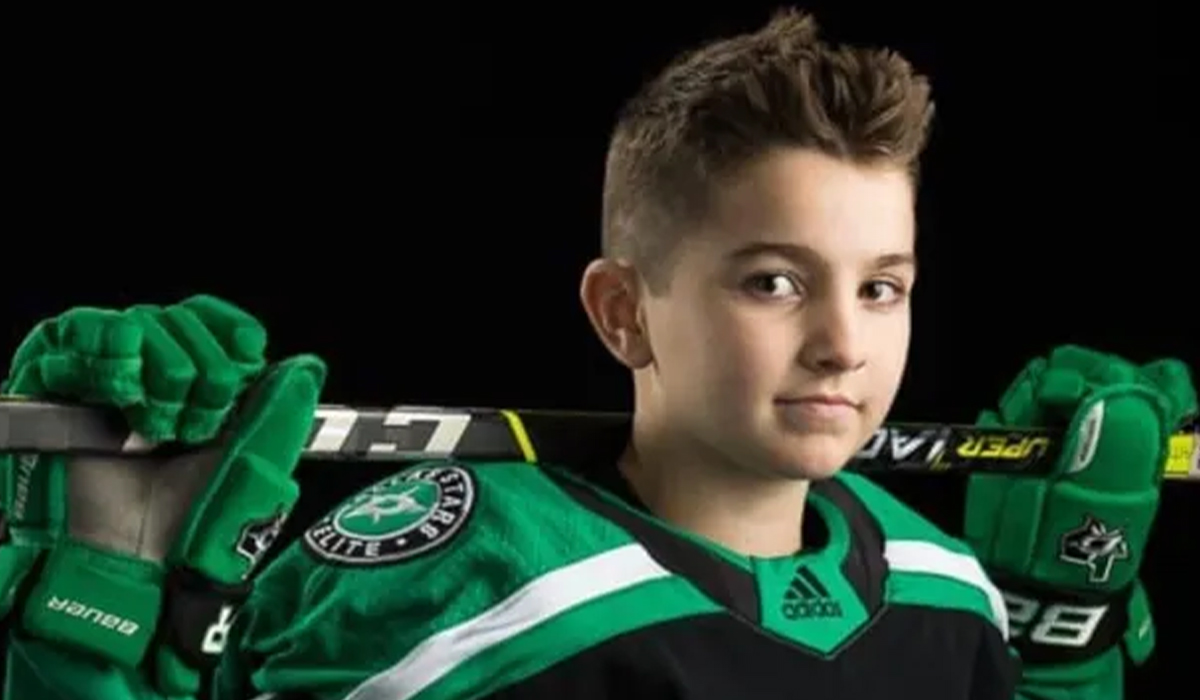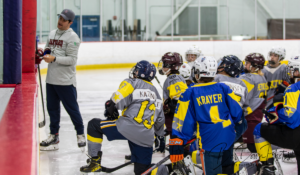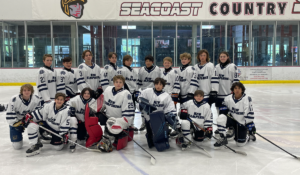One child’s journey from diagnosis to top-level competitor
In May of 2022, the day started like any other for Kade O’Rourke, a 2011-born youth hockey player from Round Rock, Texas. Kade and his father, Dave, were training in Dallas preparing to leave for a tournament in Pittsburgh while Kade’s mother, Kristy, was back home. In the days leading up to the tournament, Dave and Kristy had begun to notice changes in Kade’s behavior. He was thirsty often. They found him drinking large amounts of liquid to stay hydrated in between numerous trips to the bathroom.
“Kade was waking up in the middle of the night to go to the bathroom, which is obviously not normal for a kid his age,” said Kristy. “But Dave was up in Dallas with him at the time, so I wasn’t seeing Kade every day. I would just hear about it when we would FaceTime at dinner.”
Dave and Kristy continually had discussions about whether there might be something more serious going on with Kade. One theory questioned if it could be his sugar levels, or something more serious. Dave and Kade went back home for a weekend before the tournament, but the thought of this being a larger medical issue continued to weigh on Kristy’s mind. While Dave was having a discussion with a family friend — who was a surgeon — he was questioned if Kade was losing a visible amount of weight.
“I wasn’t sure if he was dropping weight or not, so we had him go weigh himself after he changed to go swimming and he had lost nine pounds in two months,” said Kristy.
She immediately called Kade’s primary care physician to schedule an appointment in the hopes of getting to the bottom of what could be happening with her son.
Weight loss, especially the amount that Kade had dropped despite being athletic and physically active, was a big surprise. Bells and whistles of a mother’s intuition began to go off in Kristy’s head. That’s not normal. This isn’t right. Something’s wrong. When she called to get her son an appointment with the doctor, the clinic’s earliest available opening wasn’t for nearly a week. Not good enough. Eventually, the operator on the other end of Kristy’s phone managed to squeeze them in for an appointment the following Monday morning.
“We were [at the doctor] for two minutes and they’re like, ‘You have to go to the hospital right now,’” Kristy said. “If we had waited until that Tuesday, Kade might have ended up in the ICU. He might have been in D-K-A, which is diabetic ketoacidosis. His blood was point-one away from being admitted to the I-C-U. If your blood P-H value hits seven or below the doctors said you are admitted to the I-C-U and he was at seven-point-one. Another twenty-four hours? He could have been admitted.”
The initial shock of a Type 1 diabetes diagnosis
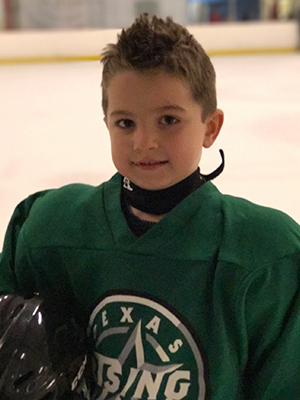
Diabetic ketoacidosis is a condition that develops when the human body can’t produce enough insulin. Insulin plays a key role in helping sugar enter the cells in the body. Without enough insulin, the body begins to break down fat as fuel. Hence, the reason for Kade’s unexpected weight loss, rampant thirst and frequent bathroom trips.
Some parents might chalk up early warning signs to just working hard, or normal fatigue for a child playing youth hockey at a high level.
“My fault was just being that tough guy,” said Dave. “‘Oh he’s fine, he’s fine, he’s working hard, ready for the tournament. He’s just working hard.’ I mean all credit goes to Kristy for forcing us to go to the doctor when we did.”
From one youth hockey mother to the masses, Kristy believes it’s important to ‘trust your gut’ in these situations. Don’t ignore the warning signs and keep pushing until there’s an answer. But Kade’s doctors did not diagnose the condition right away, leaving Kristy and Dave to continue to wonder what could be wrong with their son.
Left in limbo, whether it’s for a day, a month or longer, the mind of a worrying parent can spiral quickly.
“It is frightening what runs through your mind, you know, as a parent when you kind of are faced with that situation,” said Kristy.
The family immediately transitioned from the primary care doctors to Dell Children’s Medical Center as directed. They swung back by their home on their way, preparing for a lengthy stretch in the waiting room. Kade grabbed his iPad to keep himself occupied, maybe a snack or two to tide over a nagging appetite. The O’Rourke’s were ready to settle in for a few hours in uncomfortable waiting room chairs and HGTV on a nearby television. When the automatic doors opened up at the medical center, however, they got a much different experience.
“We literally got there and there were people waiting for us,” said Dave. “They didn’t know how [Kade] was walking. We sat down on the bed and they told us he was going straight to the I-C-U. And we needed to plan who went with him.”
‘Am I gonna be able to play youth hockey again?’
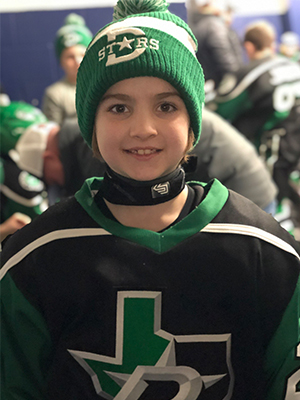
With no family history of diabetes, or friends who dealt with it, it was going to be a crash course in learning about the autoimmune disease for the family. In the process, a ‘new normal’ would be established for the O’Rourke’s.
“I didn’t know the difference between Type 1 and Type 2,” said Dave. “I thought, ‘Oh we’ll just fix this with diet’ and you know, we’ll get through this and things like that. But we were completely clueless.”
Type 1 diabetes — Kade’s diagnosis — is a chronic condition, meaning he will likely have to manage it for the rest of his life. Management includes frequent glucose tests to check his blood sugars, administering insulin injections, monitoring his diet and maintaining a healthy lifestyle.
Kade was later admitted to Dell Children’s, where a team of educators had an entire protocol set out for the family. They provided a series of classes that gave the O’Rourke’s a wealth of information, packed into eight hours.
Mom and dad were slowly coming to grips and understanding the magnitude of the situation. When a medical professional walked in and asked Kade how he was doing, his response would jolt Kristy.
“I just asked [the doctor] if I was going to be able to play hockey again,” said Kade. “That’s when it kind of hit me.”
After all, he was the one thrust into a funny blue gown that tied in the back. He was the one laying in an uncomfortable, strange bed in an unfamiliar room. He was the one poked with a needle and administered an IV drip of insulin. Lying there confused while doctors and parents exchanged questions and answers like a volley in a tennis match. A lot for a 10-year-old to process.
“It was just scary because I didn’t know what was happening,” he said. “I was scared and crying, wondering if I would be able to play hockey again. So I was nervous.”
The short answer was yes. Kade would be able to play youth hockey again.
The long answer? It’s going to take a lot of trial and error. Days, weeks, months to figure out how to manage Kade’s blood sugar levels during strenuous exercise such as practices, games and workouts. Even then, the approach to managing his insulin could change by the day, if not the hour. Kade could certainly play hockey again, but not without a total team effort and buy-in from family, friends, teammates and coaches.
Type 1 diabetes takes a team effort… literally
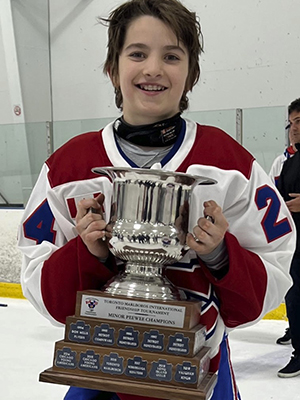
Once Kade was diagnosed with Type 1 Diabetes, it was time for Dave and Kristy to begin to understand the scope of what goes into taking care of a child with this illness.
“They pack everything that you need to know to keep your kid alive,” said Kristy. “You have that eight-hour window of education and then they send you home and you have to know how to keep your kid alive.”
On top of that, a glucose monitor was placed on Kade right away to track his blood sugar levels at all times. The pre-teen saw it as an impromptu show-and-tell opportunity with his friends. Him and his buddies huddled around, fascinated by an electronic device monitoring what’s going on in his body in real-time.
“I just don’t know how people did it before technology,” said Kristy. “But it was overwhelming and you have to learn so much in a short amount of time before your child leaves the hospital. It was very nerve-racking but they were fantastic at the hospital.”
It was education that not only had to be done by Kade and his parents, but extended family members as well. Siblings, grandparents, anyone in the immediate circle took part in an orientation course where the whole family learned what Kade, Kristy and Dave were educated on.
None of them would be on the ice with Kade though.
Coaches, teammates, even the parent group of Kade’s new team — the 2011 Toronto Jr. Canadiens — needed to have a baseline understanding of the disease.
“I knew that it would be a challenging time for Kade and his family but I also had no doubt that he had the strength and determination to persevere,” said head coach Bryan Cameron. “It was important for myself and the J-R-C family to be a support system for Kade and the O’Rourkes.”
‘JRC family’ is right. Perhaps the most special thing for Cameron was to see how Kade’s teammates adjusted to help their newfound brother in youth hockey.
“As a team we place the utmost importance on the health and well-being of our players before anything else,” said Cameron. “Everyone responded in a supportive and caring way when they found out about Kade’s diagnosis, and made it a priority to educate themselves so they could be helpful in any way possible. I’ve noticed many acts of kindness from the kids on a day-to-day basis such as helping out with monitoring his sugar levels while he’s on the ice, and participating in fundraisers.”
Help from the Hockey Community
Hockey is one of the more unique communities in all of sports. It’s like an unspoken fraternity. Whether its players, coaches or parents, there’s an instant bond formed when you cross paths with a stranger. Very few outside the sport understand the challenges and struggles, triumphs and memories. The long car rides to the rink. Weekend tournaments. Mini-sticks in the hotel hallways. Smelly gear. Moms wrapped up in blankets sitting on metal bleachers. Dads lined along the glass of the offensive zone. Conversations completely change when, “Oh, I play hockey too!” or “What age level do you coach?” and, “We’re heading to (insert far away city) here for a tournament.”
So when the O’Rourke’s were thrust into a crash course on insulin, glucose levels and dietary restrictions, the hockey community was there to help. His new team provided an invaluable support system during this transitory phase. One that even included inactive goalies on the bench monitoring his glucose while Kade was on the ice for a shift. Additionally, fellow teammate Markus Maier would be a conduit to another valuable resource for the O’Rourke’s.
“My nephew and Kade play on the same hockey team,” said Deborah Maier, founder of GoodieGoodies Organic. “My brother was having Kade and his parents over one weekend and asked me to make some desserts everyone could have.”
Maier is a scientist, educator and entrepreneur in the wellness and sports performance industries.
This introduction would be a game changer for the O’Rourke’s.
Over the next few months, Maier became a close family confidant that they would lean on frequently. Maier believes that with a case like Kade’s, it is not just about changing the foods that go into the body. It’s about understanding that maintaining a good diet is just one aspect of healthy living. In a sense, all aspects of healthy living are like wheels on a car, all working together.
“With Kade, I definitely focused on nutrition fundamentals and continuing education,” said Maier. “All my programs start with biological fundamentals. The body is a closed system, meaning all parts affect other parts. Nutrition has many components itself: eating, digestion, absorption and elimination. We need all these aspects to work together in balance for optimal performance. Any one aspect can prevent the other factors from functioning.”
Life on the ice with Type 1 diabetes
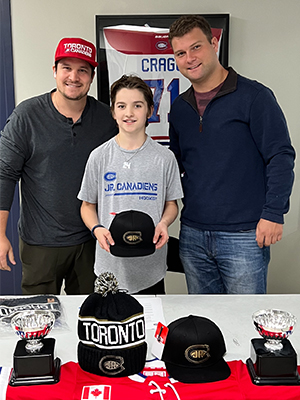
Kade was a medical marvel. Doctors were befuddled by his body’s natural ability to handle Type 1 diabetes in his current form. When he originally came into the hospital, Kade’s blood sugar levels were in the 400s. Medical professionals say kids his age would usually be lethargic and unable to skate. Meanwhile, Kade unknowingly was on the ice for two-and-a-half hours a day and exercised frequently.
For a youth hockey player like Kade, Dave said the biggest adjustment was when to administer insulin around games.
“When you’re into what they call the ‘honeymoon phase’, that’s when the adrenaline is pumped up, so Kade is still producing some insulin,” he said. “He would go into a game or even a practice and his blood levels would go up. Well, when they go up, you have to give insulin. So he would come off the ice and we would give him an injection.”
Coming off the ice, however, there’s a natural downward trend for Kade. That meant his levels would come down at the same time he was being issued insulin. The first couple weeks back at the rink became a risky game of trial and error.
‘How much insulin do we give him?’
‘What’s the right calculation?’
‘How to approach multiple games in a day versus just a practice?’
That, and much more as the O’Rourke’s tried to navigate their new normal with a new team, no less.
One trick that helped was developing some hand signals that could be seen during the game while on the bench. for example, holding up three fingers meant Kade needed to take three sugar tabs or gummies after a shift. Pointing to the tip of your finger meant he needed to test his blood sugars between periods.
During games, a phone was set next to the non-playing goalie. That player would call out Kade’s levels to him as he came off the ice . That helped him know where he was at and what, if anything, he needed to do. Go-to snacks that worked well? Applesauce pouches, sugar tabs and gummies, Kind Bars and miniature Snickers bars. Tools like Follow App, Sugarmate and Sugar Pixel have also been extremely useful.
In the summer of 2022, Kade made the move from the Dallas Stars Elite program to the Toronto Jr. Canadiens. Moving to Canada was a significant transition both on and off the ice, aside from the adjustment taking place in his life with Type 1 diabetes.
The Jr. Canadiens play in one of, if not, the most competitive youth hockey league in North America; the Greater Toronto Hockey League (GTHL). Seventy-eight alumni were on opening-night rosters when the 2022-23 NHL season began last October. Connor McDavid, Ryan O’Reilly, Mitch Marner, John Tavares, Tyler Seguin… The list of former players reads more like NHL All-Star announcements, and they all got their start in the GTHL. Not only was Kade moving halfway across the continent with a newly discovered chronic illness, the level of play on the ice was fixing to ramp up as well.
“I’ve always had my eye on him as a player and when I was informed about the potential of his family relocating to Toronto for hockey, I knew our program would be pivotal in continuing his development and success in the sport,” said Cameron. “I knew Kade was the missing piece we were looking for and was happy to help with the adjustment.”
As a standout defenseman, Kade helped the Jr. Canadiens to a 67-6-3 record. They finished second in the GTHL during the regular season. Unfortunately, they were eliminated in the semifinals of the playoffs by the Toronto Marlboros. Still, Kade’s JRC squad would rank as high as second in the World Rankings as one of the best 2011-born teams in youth hockey.
Paying it forward to others with Type 1 diabetes
With invaluable resources offered up from former teammates, as well as total buy-in from their current squad, Dave, Kristy and Kade look to help others in need. A youth hockey community that has been so good to them in such a short time, they now extend a helping hand to others in similar situations.
Kade O’Rourke from the Toronto Jr Canadiens stopped by practice today & got to join the boys in a lil’ shoot out practice.
— y – Milwaukee Admirals (@mkeadmirals) March 21, 2023
You should probably watch until the end. 👀 pic.twitter.com/PiHwwdgxPH
They launched KadeORourke.com in an effort to educate people on Type 1 diabetes, as well as the Team24 fundraiser. It’s also a direct line to the O’Rourke’s who hope to help others in the youth hockey community dealing with the disease.
“We just hope this helps out other families dealing with something like this,” said Dave. “One family, one single mom, one single dad, one kid. We’re pretty blessed with Kade’s teammates helping and his coaching staff and dietitians. We’re a very blessed family that we have an unbelievable village supporting us. But, you know, there are a lot of people that don’t have that village. So if we can just help anybody out there and say ‘It’s gonna be okay’, then that’s worth it.”
Kade hopes to one day play Division-1 college hockey at the University of Michigan and ultimately, the NHL. He draws inspiration from current NHL players such as Max Domi, Kappo Kakko and Luke Kunin. All three manage diabetes while playing hockey at its highest level. Only further proving that this disease can’t hold Kade back from achieving his dreams.
For more information on how Kade and his family manage Type 1 diabetes while playing youth hockey, visit KadeORourke.com!
